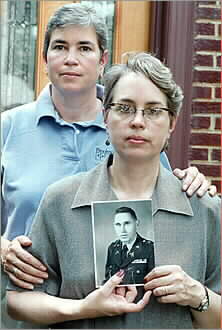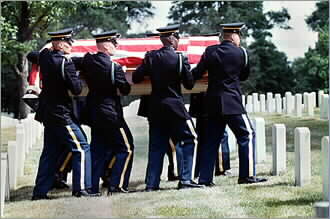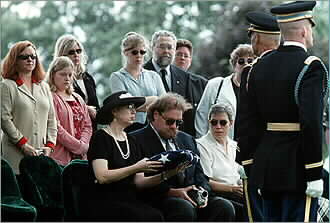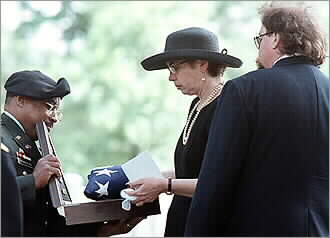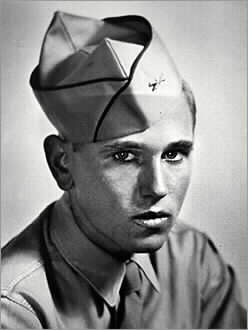Donald Eugene Parsons was born on April 17, 1929 and joined the Armed Forces while in Sparta, Illinois.
He served in the United States Army, 2 REG 1 INF (ARV) ADV TEAM4 MA, and attained the rank of Lieutenant Colonel.
Donald Eugene Parsons was listed as Missing in Action.
Also see the crew remembrance.
Courtesy of the Washington Post: 13 June 2002:
Years After Vietnam, Father Rests in Peace
Daughters Bury Remains of Long-Missing Soldier
After more than three decades of waiting, of wondering what and where and how, his daughters buried Lieutenant Colonel Donald E. Parsons on Friday with full military honors. They walked behind a horse-drawn caisson for the final journey to his gravesite at Arlington National Cemetery. They stood for the sharp report of 21 gunshots and the moving simplicity of taps. They received from a commanding officer the American flag that had been draped over their father’s casket, now folded into a sharp, taut triangle of mourning.
The casket contained little, though: A green Army uniform with all the appropriate bars of rank. And underneath the uniform, placed carefully within an Army blanket, two teeth.
Yet for those teeth, Stacy Parsons and Donna Willett were profoundly grateful. At last, they knew, their father was home.
Not until six years ago were the two meager and badly discolored relics recovered from the dense jungle where Parsons and six other soldiers had gone missing in action during the height of the Vietnam War. The discovery by a military search team was part random luck, part persistent investigation, part hard-sweat work. But confirming their identity took several more years, and so not until late 2000 did Willett pick up the phone one day in North Carolina to hear, “We have found your father’s remains.”
As the room began reeling, she held on enough to absorb the words and then call her sister in Maryland.
Hundreds of families have received similar calls in the decade since the United States began an intense recovery program in Vietnam, Laos and Cambodia — a $20 million-a-year effort that continues today, with more than 1,900 military yet unaccounted for in Southeast Asia.
For each family, that confirmation and the final homecoming can be an intense event. As these sisters explained, sitting in Parsons’s dining room in Silver Spring, it dredges up past pains, deeply felt absences that never can be compensated.
At the same time, Willett said, “it does finish the circle.”
The two women made sure of that. Before their father’s casket was sealed, they put their mother’s ashes in with his uniform, along with the miniature bride and groom that once topped their parents’ wedding cake.
“She never got over him,” Parsons said. “She never quit playing the ‘what if’ game.”
None of them did.
When Duty Calls
They know him only from their childhood, a father of infinite fun who taught his tomboy younger daughter to play football and baseball, who did a mean imitation of Lurch from “The Addams Family,” who once absconded with the “Generals Only” signs from the parking lot of an officers’ club. Donald Parsons would lie on the couch and sing, “Life is just a bowl of cherries.” But only the first line, so his girls never learned the rest of the song.
He was career military — a small-town Illinois boy who became a “tank man” — but he didn’t have to go to Vietnam. He was closing in on his 40th birthday, with a Bronze Star from Korea and nothing left to prove. Wife Patricia vehemently opposed the tour. “I’d rather have a live coward than a dead hero,” she told him.
He left anyway, duty calling. In January 1969, Lieutenant Colonel Parsons returned to the states, and he and Pat enjoyed two weeks in Hawaii. An emergency helicopter resupply mission came up the morning he got back to the war. Within hours, he was missing.
It was an early Saturday when his family heard. Donna was 12, Stacy 11, and they were living with their mother in a basement apartment across the street from grandparents in a tiny town called Blowing Rock in western North Carolina. Their daddy had moved them from Texas just before leaving for Vietnam.
In case they needed relatives nearby.
“I had just sat down with my box of cereal to watch cartoons,” Stacy Parsons remembered. There was a knock on the door. The news was dispatched quickly, and then the man was gone. “I’ve come to tell you that your husband has been declared missing in action,” the sisters remember him saying, standing in the door of their mother’s bedroom.
The world never spun on the same axis again.
Within a year, bereft over the loss of her only child, Donald Parsons’s mother killed herself. Over and over, his wife tried suicide, too, so many attempts her daughters lost count. Periodic reports that Parsons or other crew members had been sighted led to desperate hope that he was a prisoner of war, though his rank likely would have meant cruel treatment at his captors’ hands. The POWs began coming home in the early 1970s. His family searched the news footage to see if they recognized his face.
Long after even the most remote possibility existed, Willett and Parsons allowed themselves the fleeting fantasy that maybe, just maybe, their father might be alive. At Brookside Gardens, where Parsons works as a staff gardener, she has been seeing one visitor for the last 10 years. She stops every time. “He reminds me of dad. It takes me back a little bit.”
Lost, Then Found
Vietnam and the United States took their first steps toward normalized relations in 1991. In 1992, the government established the Joint Task Force Full Accounting Unit to find and repatriate remains from Southeast Asia. Only the following year, as Parsons and Willett would learn much later, teams traveling in central Quang Tri province began talking to local informants about their father’s disappearance.
From here the story is worthy of Hollywood. The informants were, in the vernacular, “bone merchants,” or villagers who had dealt with such. One produced some remains he had bought from another man. He claimed they came from a U.S. aircraft crash site not far from the Laotian border. He knew the name “Parsons, Donald.”
More villagers were interviewed, and in 1995, a man named Nguyen Van Tuyen led a team to the site. It immediately discovered fragments of wreckage and melted metal from a Huey helicopter, personal artifacts and human remains. All was sent for analysis at the Army’s Central Identification Laboratory in Hawaii, with additional testing on certain pieces done thousands of miles east by the Armed Forces DNA Identification Laboratory in Rockville. Excavation ultimately would cover 595 square meters.
A few items voluntarily offered up clues. There was the silver-colored lieutenant colonel rank insignia, the trifold plastic photo holder from a man’s wallet. The imprint of its owner’s Illinois driver’s license still was legible.
The steep hillside — so remote that it remained hidden even from locals until the mid-1980s — was less than a mile from the last place emergency beeper signals had been picked up from the helicopter after radio contact was lost. Some details his daughters learned only recently after reading the government’s report on the identification of the soldiers killed there. Their father and his crew had been trying to reach Marines trapped for a week by bad weather and enemy fire. Out of nowhere, one of those Americans who would have been on the receiving end of that resupply mission contacted Willett from Thailand last month to fill in other blanks in the story.
Bad visibility had forced the chopper to abandon its effort to reach Firebase Tornado and return to Vandergrift Combat Base a dozen or so miles away. It likely slammed into the hillside at speeds in excess of 70 mph. Surely everyone died instantly. No one was captured and tortured.
“That gives us the relief of knowing, after thinking all those years he could have been a POW,” Willett said.
Her mother, however, never knew. She died in 1999, less than a year before that official call from the Army.
One Last Goodbye
In all the years, his wife and children never held a service of any kind. They planted no marker. Of course, Donald Parsons’s name is on the Vietnam Memorial, and his younger daughter once left him a letter at the wall — and his favorite Saltine crackers.
She and her sister, now in their mid-forties, decided on burial at Arlington despite the eight-hour drive that would require of relatives still in Blowing Rock. “Because he was an Army officer and this was his career,” Stacy Parsons said. They also decided he well deserved the military honors, no matter how few would be in attendance these three decades later.
Mainly family came Friday: Willett’s husband, two sons, a daughter-in-law and the toddler who would have been a great-grandson. Parsons’s partner, some cousins, a few co-workers. In the Old Post Chapel, the empty pews were a poignant reminder of time’s passage.
The chaplain referred to the war “which now seems so long ago and so far away.” The eulogy, read on behalf of that retired Marine from Firebase Tornado, described Colonel Parsons as “one of the most morally and physically courageous soldiers I have ever met. . . . His courage, utter fearlessness and sense of duty got him killed.”
In half an hour, they were ready for the long walk to the gravesite. They passed a winding, hilly memorial section of the cemetery where hundreds of tombstones hold a place for casualties who remain missing — from Vietnam, from Korea, from World War II. They continued on to the southeast corner of Arlington, nearly in sight of the rebuilding Pentagon.
Waiting there for them under the morning’s heavy, blue-gray clouds was a bagpiper. He would conclude Parsons’s and Willett’s goodbye to their father, and they had asked him to play something appropriate.
He picked one of his own compositions, in part for its title: “What Might Have Been.”
After three decades of uncertainty, Lt. Col. Donald E. Parsons was laid to rest in Arlington National Cemetery on Friday. His daughters, Donna Parsons-Willet, front,
and Stacy Parsons, spent years speculating about their father’s fate before 2000, when they received official notification that his remains had been identified.
Parsons’s daughter Donna Parsons-Willett, center, with her
husband, Leck Willett, places the American flag that draped her
father’s coffin in its case. The coffin contained two teeth, the
only identified remains, as well as a fully decorated uniform and
the ashes of Parsons’s wife, Patricia, who died in 1999.
Finally, Resting in Peace
Parsons and five others were killed when their helicopter crashed during the height of the Vietnam War.
Identification came decades later, when U.S. officials located his remains on the black market.
A career Army officer, Parsons had earned a Bronze Star fighting in Korea. Approaching his 40th birthday, he didn’t
need to serve in Vietnam, but he felt a sense of duty and went to war. Within hours, he was missing.
PARSONS, DONALD
- LTC US ARMY
- VETERAN SERVICE DATES: 05/23/1949 – 10/03/1973
- DATE OF BIRTH: 04/17/1929
- DATE OF DEATH: 02/06/1969
- DATE OF INTERMENT: 06/07/2002
- BURIED AT: SECTION 65 SITE 3347
ARLINGTON NATIONAL CEMETERY
PARSONS, DONALD
- LTC US ARMY
- VETERAN SERVICE DATES: 05/23/1949 – 10/03/1973
- DATE OF BIRTH: 04/17/1929
- DATE OF DEATH: 02/06/1969
- DATE OF INTERMENT: 11/08/2002
- BURIED AT: SECTION 60 SITE 7899
ARLINGTON NATIONAL CEMETERY
PARSONS, PATRICIA
- DATE OF BIRTH: 06/19/1931
- DATE OF DEATH: 12/09/1999
- DATE OF INTERMENT: 06/07/2002
- BURIED AT: SECTION 65 SITE 3347
- ARLINGTON NATIONAL CEMETERY
WIFE OF PARSONS, DONALD – LTC US ARMY
Michael Robert Patterson was born in Arlington and is the son of a former officer of the US Army. So it was no wonder that sooner or later his interests drew him to American history and especially to American military history. Many of his articles can be found on renowned portals like the New York Times, Washingtonpost or Wikipedia.
Reviewed by: Michael Howard


